Despite a tumultuous year, 76% of Canadian employees and business owners say their company is growing, according to a QuickBooks survey conducted in December 2020. In fact, 20% say their business is growing more than expected. The industries expected to see the most growth in 2021 and beyond are those that connect us and care for us. We’re talking about technology, health care, and retail trade.

2021’s Fastest Growing Industries in Canada [Survey]
Online Businesses Experience Higher Growth
Unsurprisingly, businesses that operate primarily online expect to see more growth than those that operate primarily from brick-and-mortar locations. 28% of online businesses expect to exceed growth expectations this year, compared to only 14% of offline businesses. Additionally, while only 11% of online businesses say they’re not currently growing, 33% of offline businesses say the same.
And business owners are taking note. Only 22% of survey respondents say they do not sell products or services online. The remaining 78% have embraced e-commerce to some capacity.
Why Retail, Health Care, and Technology are Thriving
A few key industries are rising to the forefront when it comes to business growth in Canada. So what’s causing retail trade, health care, and software development to thrive?
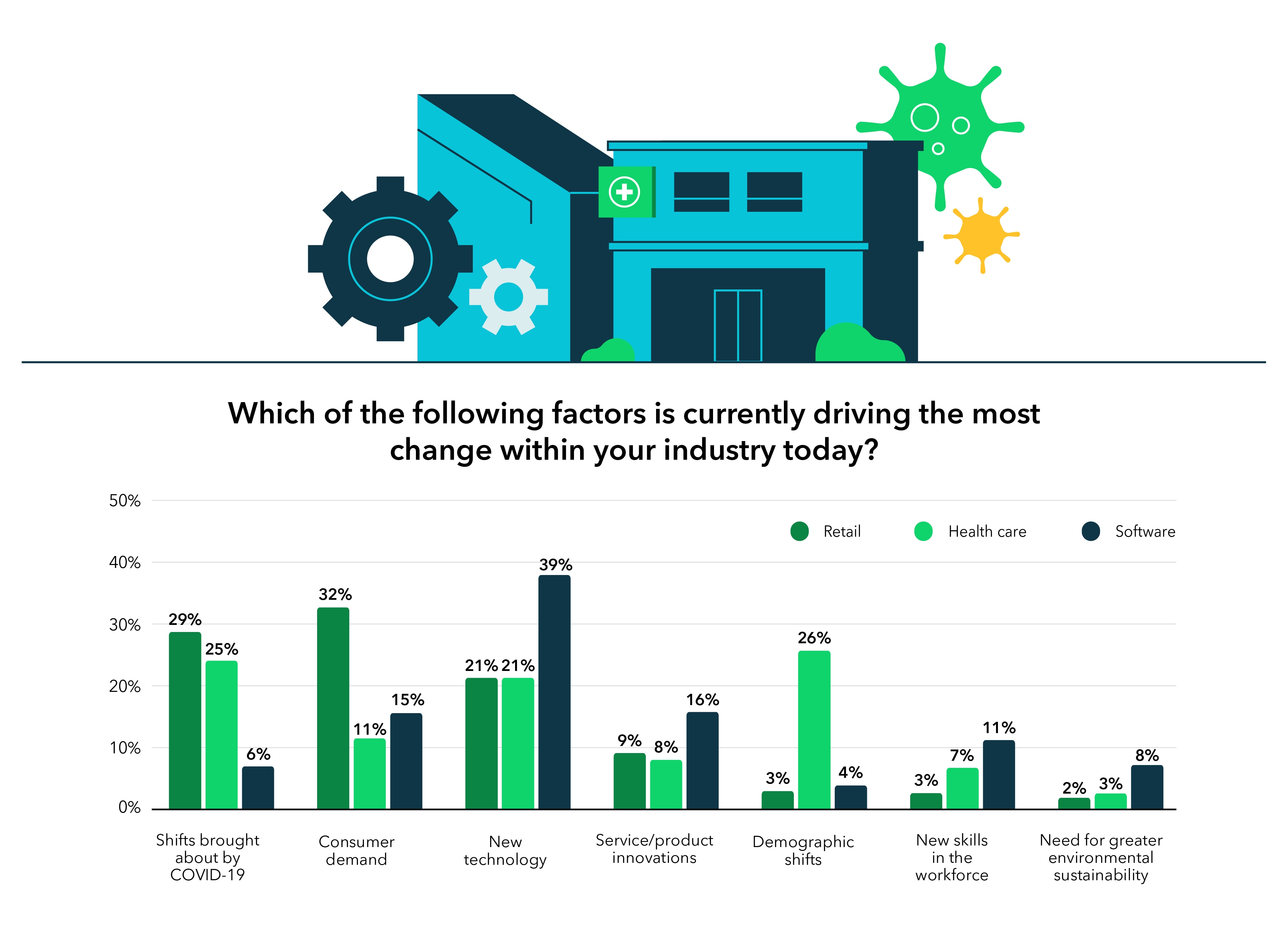
2020 was a surprisingly good year for retail trade
The lasting effects of the COVID-19 pandemic are partly responsible. While consumers sheltered in place, many of them turned to e-commerce and retail trade for solace and entertainment. Furniture sales skyrocketed in 2020, along with building material and gardening equipment, according to year-end data released by Statistics Canada.
Consumers stuck at home simply spent more time and money “spiffing up.” Electronics, sporting goods, book, and music sales were also up as consumers sought home-based forms of entertainment.
This growth is reflected in the data: 72% of managers and workers in retail trade say their business is growing. Less than 10% say their company is moving in the wrong direction in terms of growth.
COVID-19 paired with changing demographics caused the healthcare industry to soar
Experts believe that the growing popularity of the healthcare industry can be attributed in part to changing demographics and the aging population of Canada. Years of medical advancements have boosted our life expectancy, increasing the senior population. And 1 in 4 health care workers say demographic shifts drove the most change within their industry, according to survey data.
Of course, the COVID-19 pandemic played a role as well. More people were more likely to reach out to their primary care doctors in 2020 than in previous years. And that isn’t changing anytime soon. More than 72% of health care workers say their industry is growing, and only 6% say their business is shrinking.
Technological advancements drove growth for software developers
The growth of the technology industry isn’t a surprise, given Canada’s history of technological investments. Canada boasts the world’s highest-educated workforce and is home to more than 2.8 million STEM graduates. With more than 41,000 tech companies across the country, Canada is the sixth most represented country in terms of developer talent.
39% of survey respondents in the software development field said that new technology is driving change and growth for their industry. And what’s more, they believe it will continue to do so over the next decade. 82% of workers in this industry say their company is growing.
This optimism is reflected in Canada’s overall projections for job and sector growth. The Canadian healthcare industry is working to double the number of health and bioscience firms by 2025. Likewise, technology-related jobs are expected to grow between 15% and 22% by 2027, while retail is predicted to increase jobs by about 20% by 2028.
Industry Changes as a Result of COVID-19
Growth aside, these industries don’t look the same as they did 12 short months ago. Respondents say the top drivers of change across all three industries are technological advancements, shifts brought about by COVID-19, and evolving consumer demand.
COVID-19 accelerated the shift to e-commerce
Many retail trade businesses were already on the path to embracing e-commerce. The pandemic simply got them there faster. Retail e-commerce sales reached a record $3.9 billion in May 2020, a 99% increase over February of the same year. Year over year, e-commerce sales more than doubled in Canada in 2020, and there seems to be no end in sight. Consumers have adapted to the convenience of e-commerce, and experts expect an additional 5.21 million users to shop online in Canada in 2021.
For retail trade industry workers, these shifts in consumer demand and the lasting impacts of the pandemic were the top drivers of change in 2020. Offline businesses struggled to meet changing consumer demands, while online businesses scrambled to adapt to demographic changes, technological advancements, and product innovations.
By the end of 2020, 64% of retail respondents said they invested in omnichannel or multichannel sales strategies, which combine online and offline sales. Another 12% said they operate entirely online. Only 24% said they still do not sell products or services online.
Evolving technology made adapting to a digital environment easier
New technology became increasingly important for online and omnichannel retail businesses. More than 23% of survey respondents said new technology drove real change within their industry — and will continue to do so over the next decade.
Retail businesses that previously operated primarily offline turned to new technologies to help them build a digital platform in a pinch. For many, that included adopting digital payment options. After all, 59% of Canadian shoppers prefer using a credit card when shopping online, and another 20% prefer electronic platforms like PayPal or Apple Pay. As COVID-19 restrictions begin to loosen, consumers will continue to rely on these contactless payment methods both online and in person.
Respondents said these changes are here to stay
Almost every single respondent (96%) said their business was impacted by COVID-19. 44% said the changes they made as a result of the pandemic (things like embracing e-commerce, working remotely, or rearranging floor space) are permanent. The majority of respondents believe these changes had a positive impact on their business.
61% of businesses across all three industries agree that the shifts and changes brought about by the pandemic have been mostly positive. They expect new technologies, consumer demand, and product or service innovations to continue to drive change within their industries over the next decade.
For most, change is a good thing
56% of respondents in the healthcare industry say the changes they’ve made in response to COVID-19 have been all or mostly positive. That number jumps to 76% for software developers.
But retail workers are struggling to adapt to change more than the other industries. Only 45% of these workers say the changes have been positive, while 23% say they’ve had a negative impact on the business. The majority of these workers (55%) say the changes are only temporary. However, businesses that made permanent changes feel more positive than those who plan to revert back to the old way of doing business after the pandemic.
Unsurprisingly, businesses that operate online in some capacity, either before or after COVID-19, feel the most optimistic about the future. 86% of these respondents say the changes they’ve made have been neutral or positive for their business. And more than 63% of primarily online businesses say the changes they implemented are permanent.
New Businesses are on the Rise
Despite the challenges of 2020, rising entrepreneurs still want to start a new business in 2021 and beyond. 68% of respondents say they have plans to start their own business one day, and another 13% are considering it. Of those who have already owned a business, 83% say they plan to open another.
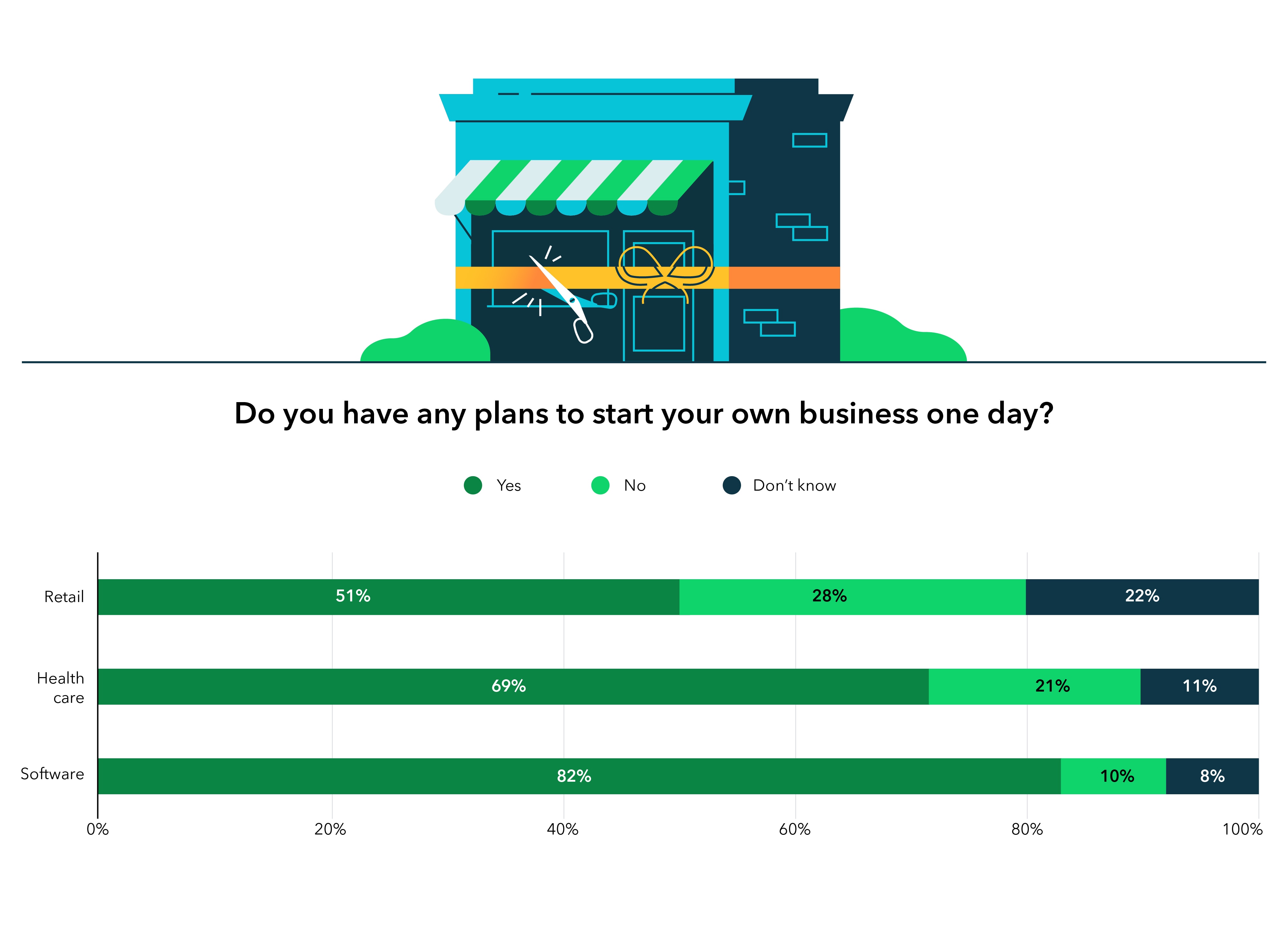
But entrepreneurs are more optimistic about some industries than others. 82% of respondents in the technology industry say they want to start their own business. By contrast, only 51% of those in the retail trade and 69% of those in health care plan to start a new business.
Why are tech workers feeling so optimistic? Workers in the technology industry are more likely to have seen success before. 63% of these workers say they have owned a successful business before—and 78% plan to start another business. The majority of healthcare workers (62%) have not owned a business before, but they’re interested in giving it a try. Meanwhile, 58% of retail workers say they have owned a business before, but only 33% say they would do it again.
Defining success for new business owners
These new business owners may have a different definition of success than their predecessors.
For most, professional success is defined as:
- Financial growth
- Financial stability
- Customer satisfaction
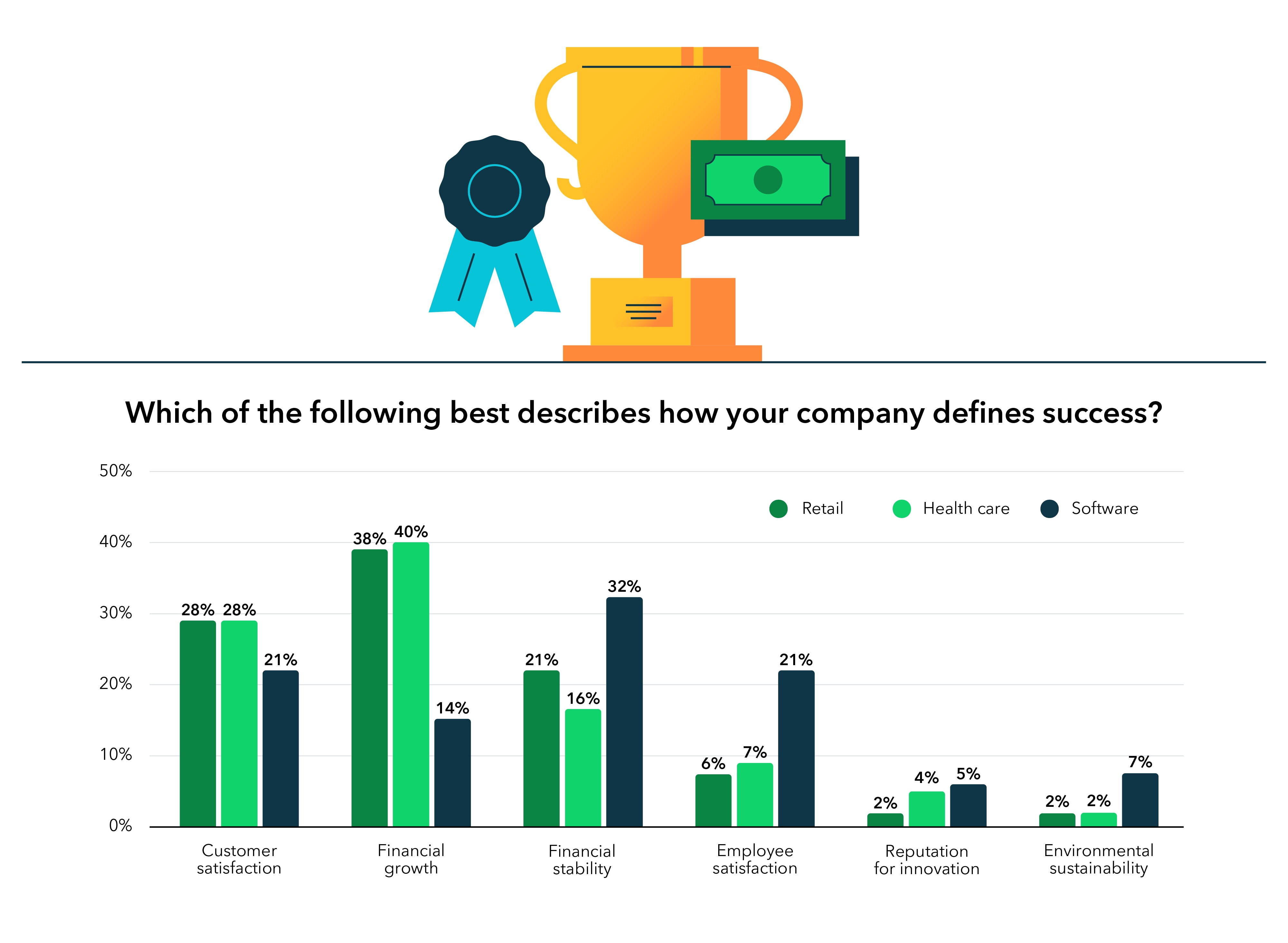
From a personal perspective, the majority of these business owners and employees measure success based on financial earnings.
Health care and retail workers are more focused on financial growth and customer satisfaction. On a personal level, workers in the retail trade believe happiness and personal achievement are indicators of success.
In the tech world, financial stability and employee satisfaction are top success metrics. The tech industry is more likely to value employee satisfaction than other industries. Software developers and others in the tech industry are more likely to define personal success as independence and reputation.
Holding a reputation for innovation or focusing on environmental sustainability aren’t critical definers of success for any of the top three industries.
Challenges new business owners could face in 2021 and beyond
All businesses face startup challenges, and new businesses are no exception.
Seasoned business owners say the top challenges new businesses are likely to face include:
- Securing funding
- Labour and skills shortages
- Building a customer base
Experts believe retailers may face challenges learning to make money from e-commerce sales where net profit margins could be considerably less than they’re used to. Indeed, more retail business owners say they struggled with establishing an online presence and managing cash flow when they were starting up.
Experienced business owners say focusing on financial management, hiring the right people, and building a solid marketing plan are essential skills for new business owners. More than 40% of these business owners said it took two years to recoup their startup costs and three years to become profitable. This points to why things like cash flow and accounting systems are so important to master upfront. Interestingly, retail businesses were more likely to become profitable faster, within one or two years.
Customer service could be the key to success
When it comes to their own businesses, seasoned business owners say the keys to success are:
- Providing great customer service
- Building effective marketing and sales plans
- Offering quality products and services
Unsurprisingly, a positive customer service experience is especially important for those in the health care and retail trades.
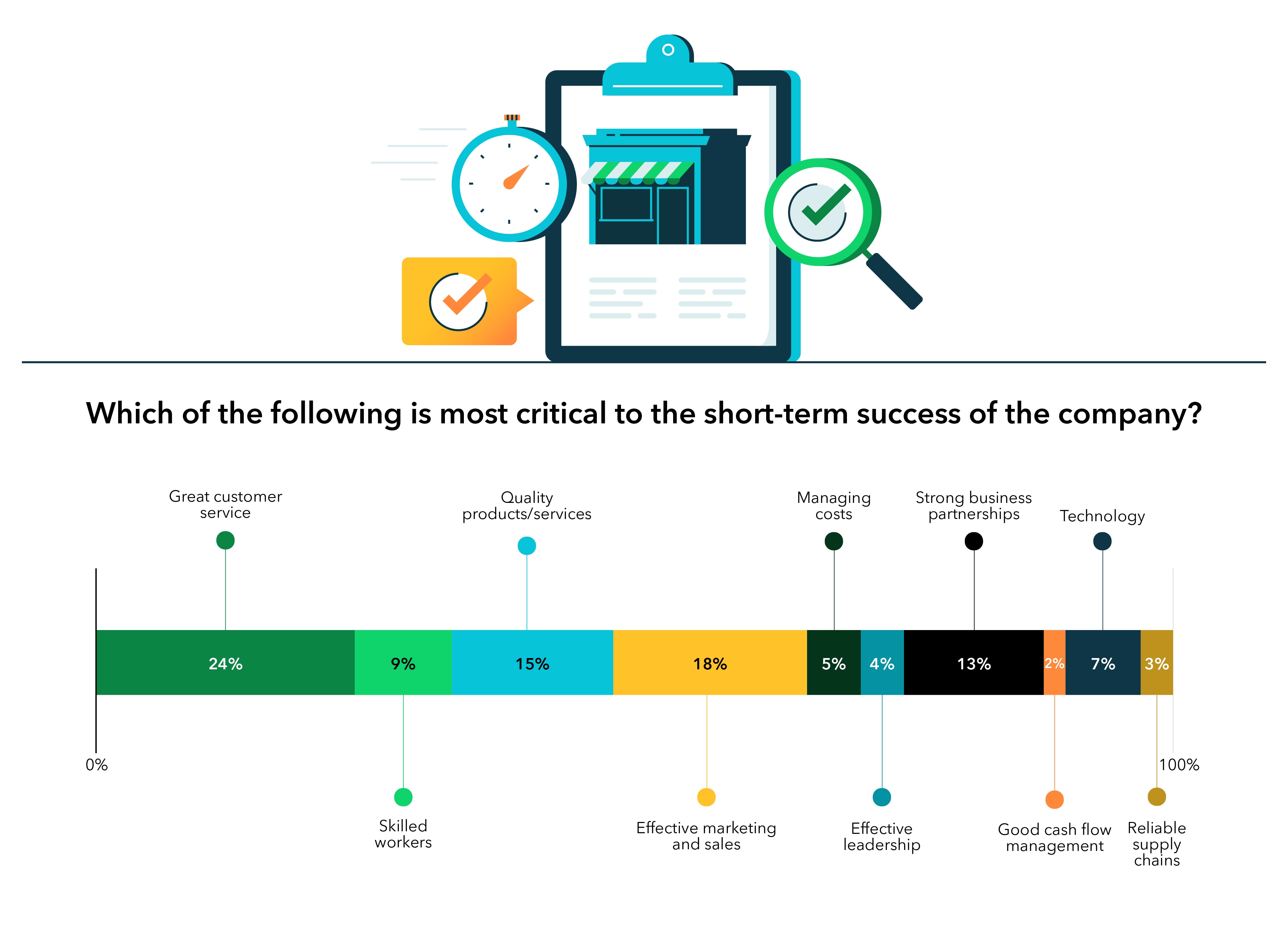
Job Satisfaction Among Industries
Success is one thing, but satisfaction is another. Employees who define success by financial earnings and financial growth are more likely to be satisfied with their careers. Likewise, employees working for thriving online companies feel more satisfied. 70% of these workers are moderately or extremely satisfied with their careers.
Surprisingly, those who feel very satisfied with their career are more likely to want to own their own business or make plans to start a new business.
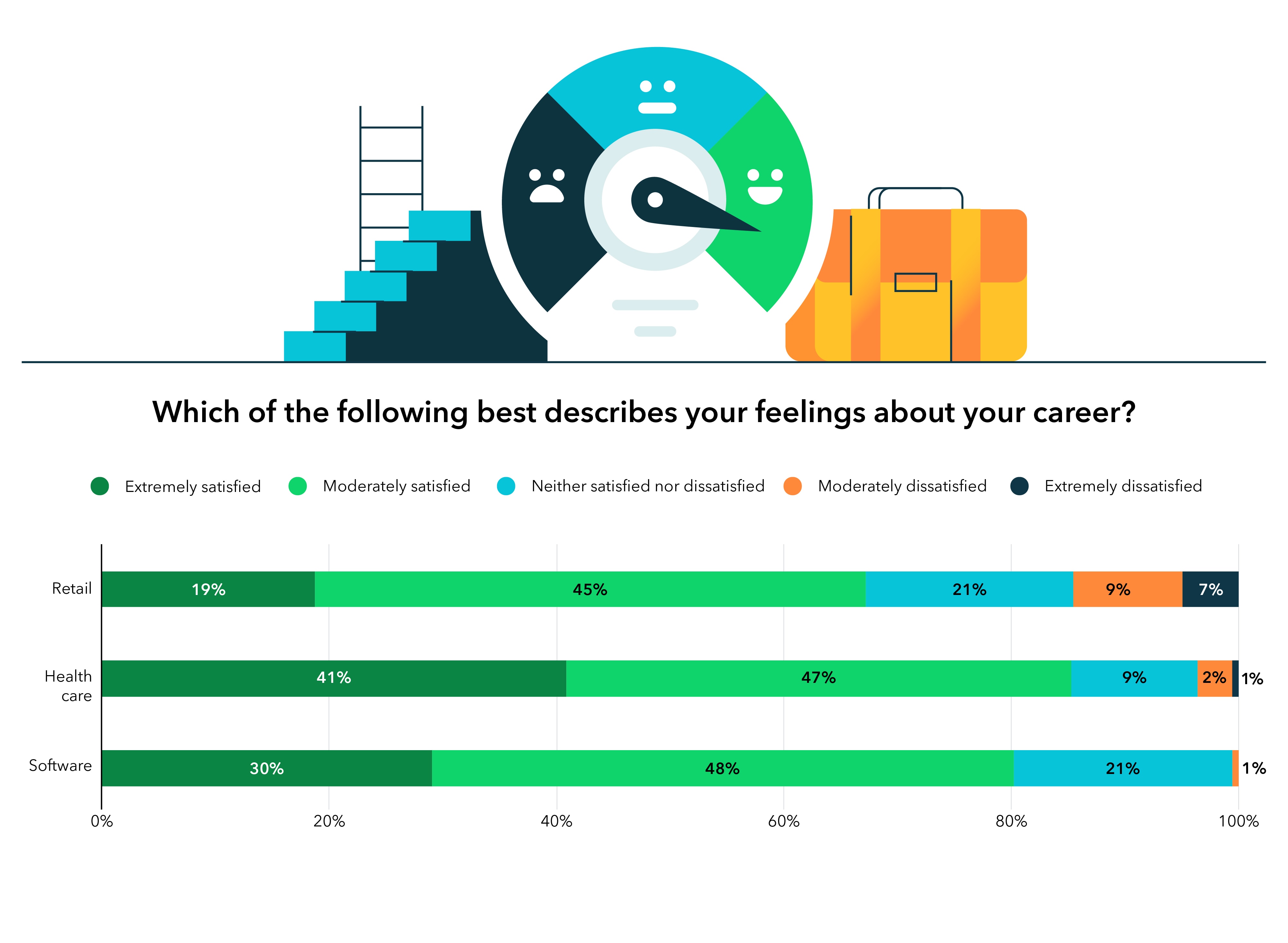
Retail trade workers are less satisfied with their careers
While employees are generally satisfied with their careers (78% say they’re moderately or extremely satisfied with their career), retail trade workers are less satisfied than others. Only 64% of these employees say they’re satisfied with their career. Compare this to 78% of workers in software development and 88% of workers in the health care industry.
Nonetheless, 75% of employees across all industries (including 57% of retail workers) say they would still encourage others to follow a similar career path.
Healthcare and tech workers are more satisfied with their education
79% of workers across all three industries say they feel moderately or extremely satisfied with how well their education prepared them for their career. Software developers and health care workers feel especially confident, with 89% of each group satisfied with how their education prepared them for the workforce. And the majority of each group feel confident in the Canadian education system’s ability to meet the skills needs of the future workforce.
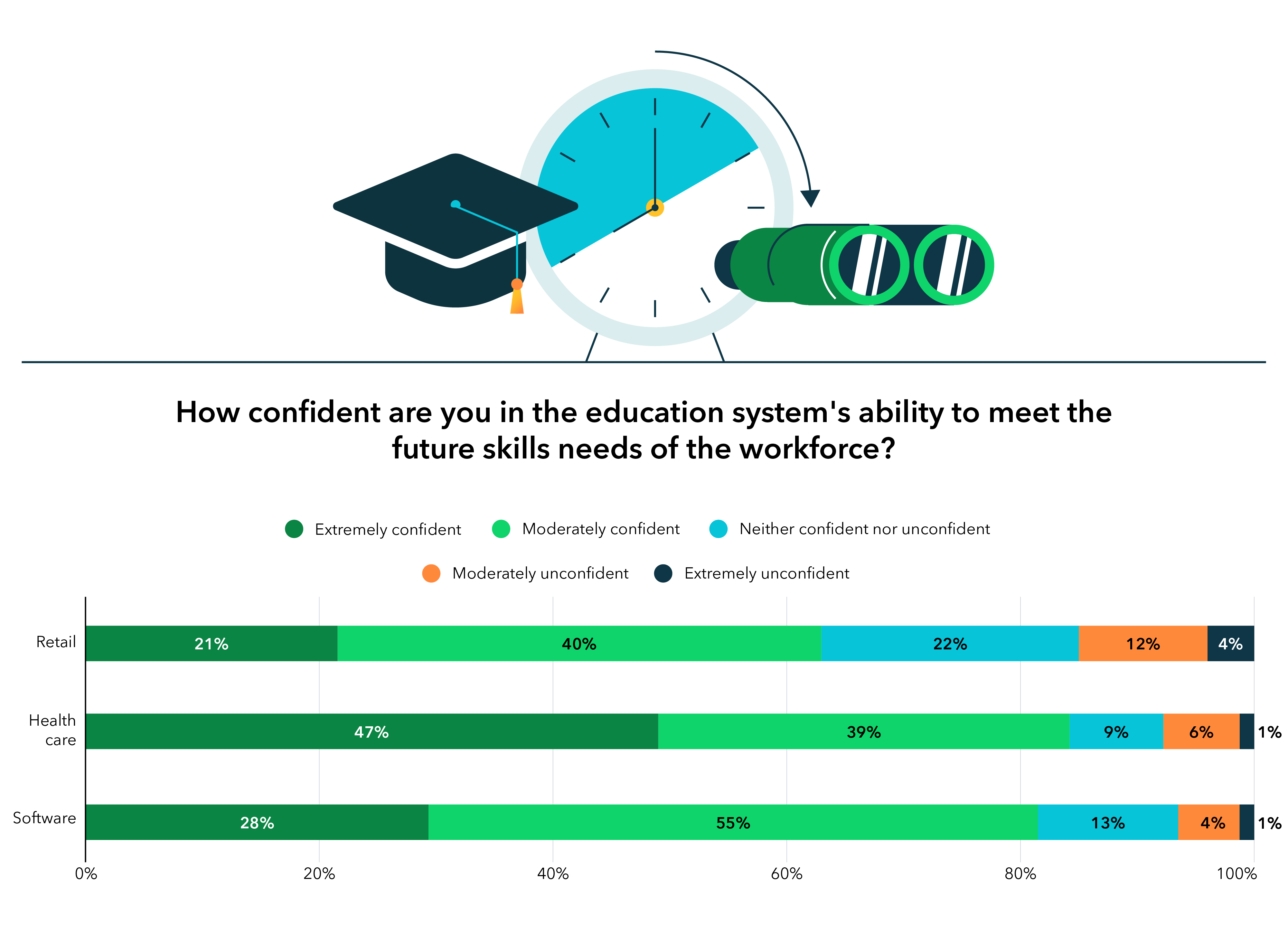
On the flip side, only 55% of retail workers say their education prepared them for their current job. And 61% feel confident in the education of the future retail workforce.
No matter what their education, the majority of respondents agree that employees require additional training to do their jobs correctly. This is especially true for those in the healthcare industry: nearly half of these workers say additional training is integral to the job.
Growing Businesses Focus on Diversity
As companies grow, so do their teams. And in the aftermath of 2020, more businesses are making diversity a priority when it comes to hiring top talent. 79% of respondents say building a diverse workforce is a top priority for their business.
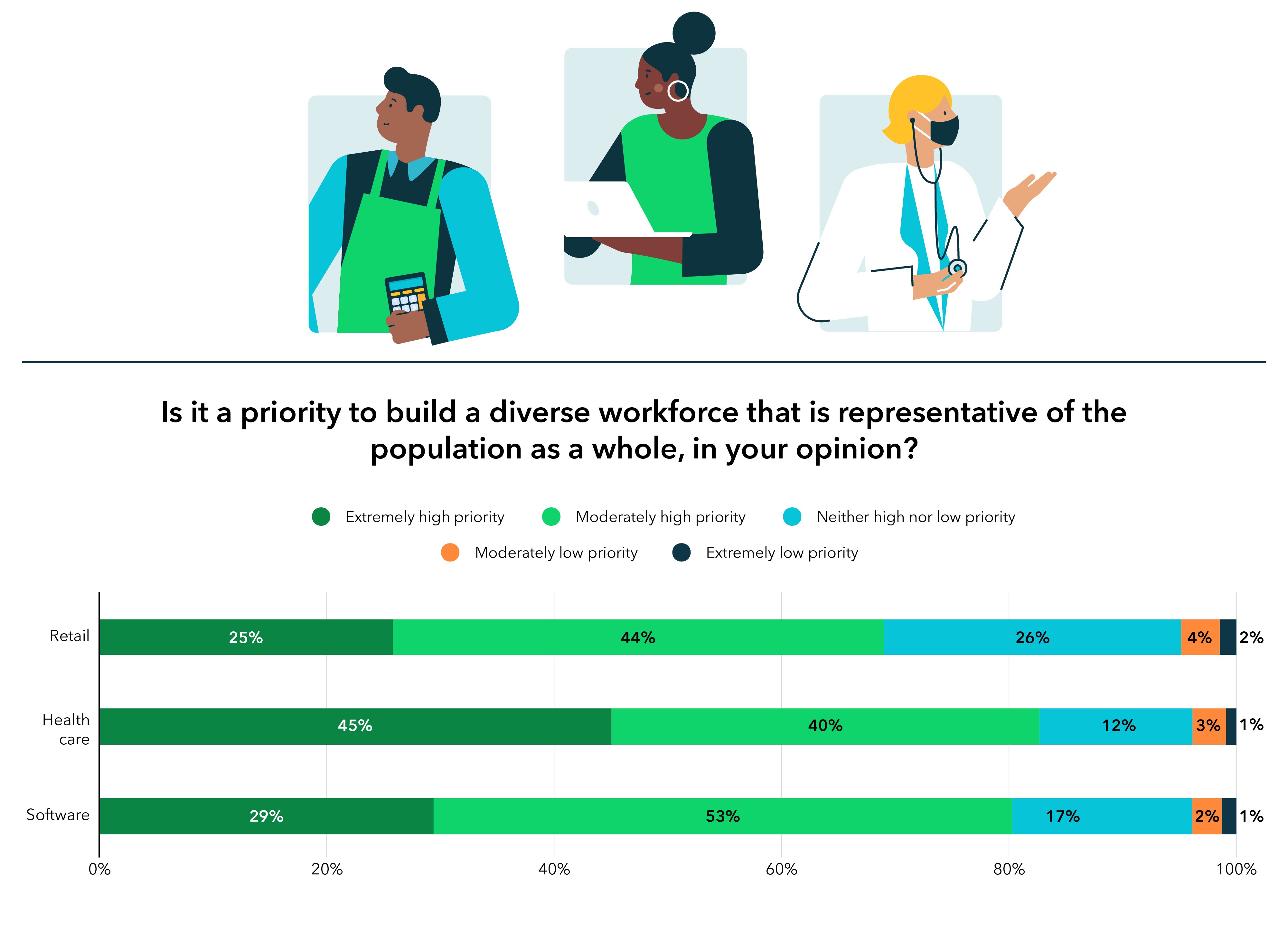
And growing companies are more focused on diversity than those who are stagnant or focused on contracting. 84% of growing companies say diversity is a high priority within their business, compared to 63% of companies experiencing little to no growth.
Good news: new business owners are following suit. 40% of those planning to open a business say diversity in the workplace is an extremely high priority, and another 43% say it’s moderately high.
Research Methodology and Sample
In December 2020, QuickBooks used an online survey with 29 questions to collect data from 1,180 employees and business owners in Canada. Survey respondents worked in retail trade, health care, and software development (~400 people for each industry). The audience panels were provided by PollFish, with a 51:49 split between male and female respondents. 61% of the respondents were employees; 25% were managers; 7% were directors, vice presidents, or senior vice presidents; and 7% were company presidents or business owners. The remainder described their job title as “other.”
Note that some survey questions in the charts shown above have been abbreviated for legibility. (For example, neutral questions used in the questionnaire, such as “How satisfied or dissatisfied are you …?” were edited to “How satisfied are you …?”)
Where percentages in the charts do not add up to 100%, this is due to the numbers being rounded to the nearest decimal place for visual clarity.



